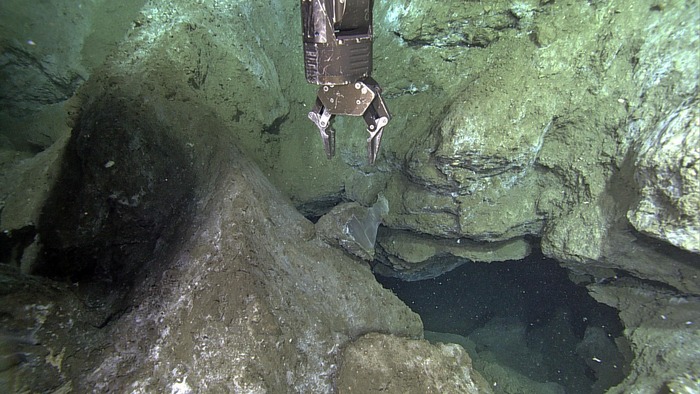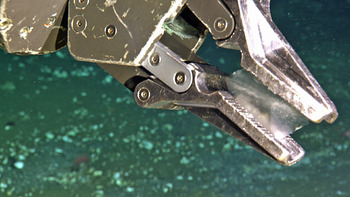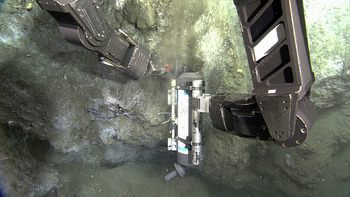Today was marked by two incredibly exciting events:
•The successful streaming of live HD video from a cabled camera located >300 miles offshore at the largest volcano on the Juan de Fuca Ridge – Axial Seamount. The imagery was streamed through the seafloor cable to the University of Washington as part of the test phase of this OOI instrument, which images an active hot spring in the ASHES hydrothermal field at a water depth of 5000 ft beneath the ocean’s surface.
•The discovery, for the first time, of exposed methane hydrate at the summit of Southern Hydrate Ridge.
During a long dive with the ROV ROPOS to Southern Hydrate Ridge (SHR) last night and into the morning today, all infrastructure is now completely installed at this site, including both cabled and uncabled instruments, and all required fluid and sediment samples have been taken.
It was an extraordinary dive with the exciting discovery of a small boulder of methane hydrate exposed on the seafloor adjacent to a jet of methane bubbles issuing from a very large collapse zone. The ice-methane compound is comprised of a lattice of water that entraps methane and forms a solid compound. Hydrate has never been seen directly exposed on the seafloor at Southern Hydrate Ridge. In 2010, when the RSN team was first here during a site survey to determine where cables and instruments should be sited, this area was characterized by a gentle hummocky topography with bacterial mats and clams. Over the ensuing four years, the seafloor has collapsed forming an irregular, steep-sided "gully" inside of which is extremely rugged topography marked by two very large openings in the near vertical walls.
Very early this morning, we spotted an odd-looking block near the two holes at the base the wall. The block was translucent white with a thin rind of sediment. The ROV picked up a small adjacent sample and it was very clear that this was methane hydrate when a small broken piece in the jaw wafted away, clearly less dense than seawater.
There were abundant smiles and high-fives from the science team and numerous students in the control room, and many thanks were given to the ROV pilots for their careful sampling of this delicate deposit. While there, a tremendous jet of methane bubbles issued from one of the large holes. We watched this continuous stream for several minutes, enthralled by the intensity of venting and the size of the plume. Alas, other OOI duties called us away, but with luck this site will still be active next year when we return!




